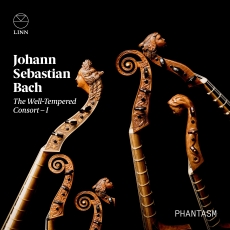Phantasm - J.S. Bach: The Well-Tempered Consort – I - Early Music Review
Not since I was captivated by Fretwork’s Art of Fugue, have I so enjoyed Bach on a viol consort. The playing on this CD is quite excellent and the music chosen translates well into playing by a consort. This medium for Bach’s polyphony seems in entirely natural succession to the great English consorts of Jenkins, Lawes and Purcell as the style and techniques developed by Byrd and Gibbons move into the heart of the Baroque.
The disc starts and concludes with Ricercars from the Musical Offering and in between there are a number of transcriptions mainly, though not entirely – there are some versions of fugues for organ and some chorale preludes – from Book I of the Well-Tempered Clavier, hinting that a companion volume will appear. For a taster listen to track 12 (Fugue No 24 from Book I, BWV 869 in B minor), and the clarity and innate reciprocity of the fugal movements (in particular) will demonstrate how apt this medium is for giving us both a domestic-scaled and yet rich and sensuous performance.
Their take on the great E flat fugue from the end of the Clavier-Übung III is interesting: the final section goes at the lick its time signature implies, and they play it in D so to those used to hearing it at 415 aren’t too thrown. It is a long way from a rumbling performance on a cathedral organ – and as invigorating as the C major fugue BWV547, which is light and faster than I had ever conceived it on the organ. These performances will make you look at music you thought you knew well through new eyes. But it is also music-making of the highest quality; I found the five-part chorale prelude An Wasserflüßen Babylon (BWV 653b) with its double pedal scoring particularly satisfying on viols as the interplay between the parts develops, in spite of this being a chorale prelude with a very distinctive ‘solo’ feel to the chorale melody as the topmost part.
Perhaps this is because the reverse principle of sourcing material for chorale preludes is already well-established by Bach himself who most obviously transcribed movements from his cantatas into the Schübler Chorales for organ, published late in his life.
Hearing the reverse transcriptions is somehow neither surprising nor improper. Phantasm’s new recording home in Berlin has fine acoustics, and this CD is beautifully recorded, so we can look forward to the companion volumes eagerly.

